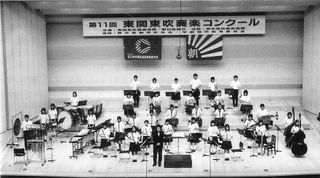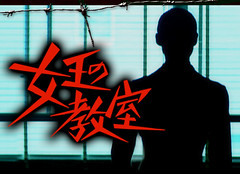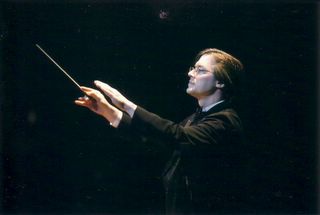It's That Time of the Year Again

This is this year's concert program. Don't ask me where the idea for the motif came from. Most of the time I have no idea.
Last year's regular concert was an extremely ambitious, two-day affair separated into Wind/Jazz Night and Orchestra Night. From a performance standpoint, it was spectacular, but it was a logistical and operational nightmare. This year we decided to go back to a single program, this time in the afternoon, but we stretched it out into three hours. There was a lot of concern about whether the brass section would hold up, but it still seemed the best way to go.
The program may have been shorter this time, but there was no wanting for flair. Quite the opposite, in fact. The music program was currently at a peak, particularly with regard to the brass section, and we would be losing a whole bunch of power players, so we decided to flaunt it while we had it. We displayed this in no uncertain terms with the opening, in which all the brass sections plus the sax section marched out onto the stage and cut loose with John Williams' Olympic Fanfare from the 1984 L.A. Olympics. That in itself was pretty impressive, I thought. And that was just the beginning...
Next up was my part of the program, the Seishin Flying Eggheads jazz big band. I actually decided to play it safe this year, mainly to save the brass players' chops. There were no screaming Maynard Ferguson or Chase tunes on the roster, neither were there any extended, unaccompanied solo breaks or whole sections ad-libbing together. It was kind of a low-key set, but I think that actually helped the kids relax a bit and get in the groove. They looked happy (at least happier than usual), they sounded fine, they were tight, and they pulled off one of their best performances ever. We started with the R&B favorite "I Heard It Through the Grapevine" followed by a 50s-style rock n' roll (sorry, Paul, "shuffle swing") chart called "Run With It" that featured the sax section. Then we toned it down with a Latin-style ballad called "Beneath an Orange Moon" that featured some fantastic solo work by lead trumpet Daichi Onizawa. This led into "Blue Bossa", perhaps our theme tune for the past year as we performed it many times and got many requests for it. This time we beefed it up a bit, supplementing the sax and trumpet spots with a well-executed bass solo (by departing 11th grader Kana Kitazawa) and some cool solo break work by the percussion section. Next, while the bassist put away her electric and got out her upright wood bass, I told a bit about the history of jazz and then, in salute to the roots of the big band, we closed out the show with "Take the A Train" and "A String of Pearls", the latter featuring a trade-off of debut solos from our two 8th grade sax players that included some amusing stage antics. When it was done, I stood the band up, bowed, and then immediately counted off the encore, "In the Mood", a number that always gets the crowd going.
All in all, it was a very entertaining and well-performed set, and the kids were definitely in the groove for a change. It wasn't perfect, but, then again, if it's perfect it's not jazz.
After a 15-minute intermission the concert band came on, directed by Mr. Karatsu (who stillreminds me a lot of Dewkid!). Their program was rather ambitious. They opened with an ensemble in which the lead and backing players were reversed and the senior members deleted altogether. They played "Sinfonia Nobilissima", which is pretty standard concert band fare. After that, the senior members came in, everyone assumed his or her usual post, and they played the tune that took them all the way to a silver medal at the regional championships last summer, "Antiphonale for Brass Sextet and Band". That is a weirdly intimidating and jarring piece, going from mysterious, close harmony to atonal noise to haunting melodies to discordant shrieking to loud power chords. It is also very impressive when played well. (At the contest they used a smaller ensemble consisting almost exclusively of senior high kids. Not surprisingly, it sounded tighter then than now, but it's still a wild ride!) They closed their set with Alfred Reed's "Praise Jerusalem!", which is based on Armenian church music and is very melodic (and, as with most of Reed's works, has plenty of punch). For the encore, they played an excerpt from Van der Roost's Jewish dance work, "Puszta", with the entire band playing the last few notes of the piece and then jumping up and yelling "HEY!" It was pretty melodramatic, I can tell you.

The Seishin Gakuen concert band at the East Kanto Regional Championship, autumn 2005.
After that, there was another intermission, and then the orchestra came on under the baton of Mssr. Maestro Ogawa. If the audience thought they were impressed up till then, they hadn't seen anything yet. This time Mr. Ogawa took an extraordinary risk; they performed Tchaikowski's 6th Symphony. The 6th is called "Pathetique", not because it's pathetic but because it is an exploration of the emotion of sadness. When one hears the name "Tchaikowski", one usually imagines either the dramatic imagery of his ballets or the martial flair of "1812 Overture" and "March Slavonica". Well, in "Pathetique" there is some unbelievably raw emotion, enough to rival Wagner or any heavy metal band. It starts out with one sitting in a dark room holding his head in his hands, progresses to standing in the middle of said room shrieking at the top of his lungs and pounding the walls, switches to "Oh, why am I bothering myself with this crap when there're things to see and people to do," and then ends with the walls suddenly closing in again, this time for good. My God...that ENDING! A low and richly melancholy cello/contrabass rumble that just trails away into dead silence...silence that is, in itself, the closing fermata. The audience just sits there numb, waiting for it all to sink in, before finally realizing that it's all over. Then they go crazy.
It is hard to express the level of musicianship required by a piece like this. I'm not talking about the level of technique required, though it is considerable. You can play the tune exactly as written with perfect precision, and you would be not only playing it wrong, but butchering it. You can't play a piece like that as it appears on paper! That's the trap that most youth orchestras fall into simply because the kids and their directors don't know better. A real symphony requires musical sense as well as a deep awareness of what is happening within the musical work. The Seishin Orchestra is currently at a stage where the kids can do that to a remarkable extent, and this performance reflected that.
As expected, the wind players were starting to show signs of wear. They had already been forced to go through a three-day marathon of rehearsals (over my protests) not to mention the brutal chop-busters in the concert band set (since Mr. Karatsu refused to show any mercy...he was out for MEAT!!!!). Frankly, I was amazed they did as well as they did. During the first and second movements of "Pathetique" there were a few pretty clear splats in the trumpets and horns, but then they found their legs again and pulled it together for the demanding third and fourth movements. All in all, it was an impressive performance. The fact that it was carried out by a group of kids whose average age is 15, many of whom have played their instruments for only a couple of years at best, is nothing short of miraculous.

The Seishin Gakuen orchestra at the All-Japan Selective High School Orchestra Festa in December 2005
Personally, however, I think the most moving performance by far was the encore. I'm sure a lot of my feeling that way has to do with the fact that I arranged the piece myself. I'm talking about the "'Time to Say Goodbye' meets Ravel's 'Bolero'" creation that I discussed before. I crafted that work specifically for this event, and I designed it to showcase as many of the 11th grade members as possible. It was their final appearance with the Seishin Gakuen music club, after all, so it really was time to say goodbye.
So imagine if you will:
After three curtain calls to rousing applause following "Pathetique", Mr. Ogawa signals the orchestra to sit, and the stage goes to total darkness. Then, toward stage left, a spotlight slowly fades in to reveal Eri Kitaki, who starts the opening melody of "Time to Say Goodbye" freely and without accompaniment. It sounds so lonely...so desolate. Eri has only been with us for a little over a year. She was a "Room 5" student, i.e. she entered our senior high from a different junior high, but she waited almost till the end of her first year to join us. Over the past year she has been in the concert band and has also alternated on lead in the Flying Eggheads. She's a serious and determined player. However, she's also notoriously inconsistent, as the two unfortunate bricks in her solo show.
Eri hits her final note, which fades away as another instrument comes in together with a spot toward stage right. It's Asuka Uchiura on tenor sax. She has been my loyal captain of the Flying Eggheads for the past year and a very strong jazz player. That's not bad at all, especially considering that, in her 7th and 8th grade years, the term "airhead" would have been too kind. Back then she had a noted tendency to just sit and stare blankly without any idea what was going on around her. Needless to say, her grades stank, and her early attempts at playing weren't much more promising. But that was then, and this is most definitely now. She did an outstanding job in tonight's Flying Egghead set, ad-libbing with confidence with a tone worthy of a professional. Now, in a classical mode, she is playing flawlessly.
It sounds even more beautiful a few measures in when, together with yet another spotlight, Miho Watanabe comes in to accompany her on harp. Miho was another tough one to figure out at first. Academically capable but scatter-brained and excessively emotional, she had a brief flirtation with the "bad" crowd in her mid to late junior high days before she cleaned up her act and started showing both maturity and leadership ability. A naturally talented pianist and percussionist, she took up harp and struggled hard to get a handle on it...only to break her hand when she was needed most. Mr. Ogawa was pretty hard on her for that, and she never forgave herself. I wrote that harp part specifically for her as her farewell performance, but I had to work to convince her to do it (she wanted to play snare). I'm glad she did, and the tears I see in the eyes of some people backstage show others think so, too. She should consider herself more than redeemed.
The harp/sax duet comes to a conclusion, and a single snare starts the Bolero beat but in 4/4 time. Then the cellos and violas come plucking in. After a few bars, Chiaki Oshima plays a low, subdued opening solo on flute. She's still only a 10th grader and so isn't leaving us yet (thank god), but she still deserves mention. An excellent flautist and an award-winning pianist (for the Eggheads and numerous solos throughout the year), she is one of our crowned stars, so it's only fitting that she get a bit of spotlight. She's followed immediately by a similarly minimal solo played beautifully on clarinet by Ryouka Takasu. Ryouka is a departing 11th grader, and her story is a troubled one. When she first joined us as a 7th grader, she quickly earned a reputation as a whiner who often made false accusations, which kept her reputation in the gutter. However, she immediately showed strength on clarinet...and when she played piano at the chorus concert she blew away all the older competition. She won awards both as a soloist on clarinet and as an accompanist for others on piano. Then, halfway through her 9th grade year, she developed an inner ear infection. Her doctor ordered her to give up music. She did so with much flowing of tears. It didn't last. As soon as the infection had subsided a bit, she immediately came running back. That was last year. She could barely play, and it hurt. It took a lot of work for her to get her chops back, but she made it to the East Kanto Regional Solo Championship only a couple of months ago with Chiaki Oshima accompanying her, and they both got gold medals! (Unfortunately, Ryouka was in fourth place overall, and only the top three went on to the nationals.) The only problem is that she is now totally deaf in one ear. She doesn't seem to consider it a vain sacrifice, and I won't argue with her.
The accompaniment fills out a bit, adding the second violins and a flute, and the dynamics grow a bit. Then we hear the melody of the chorus of "Time to Say Goodbye" played through fully for the first time, this time by Yumeka Noguchi on bassoon. Like Eri Kitaki, Yumeka was a "Room 5" student who came from another junior high. When she first came to me in the music office almost two years ago, she seemed really cold and withdrawn when she said (without making eye contact), "I can play saxophone. Any is okay." I then told her that we didn't really need another sax player, but we desperately needed a new bassoonist. She wasn't happy, and it took her more than a month of stewing and pensive blatting on a bassoon in an isolated corner before she said she'd do it. (She later told me that she'd never played classical music in her life since her junior high band had only played pop tunes. That made it even tougher for her.) I was really worried about her, especially because she continued to seem like a hopeless wall flower. Boy, oh boy, was I wrong. Come summer, she suddenly went crazy, and she quickly turned our whole program upside down. (She was the inspiration for the song "In Your Ranks" on my Open Halls album.) She started inventing themes, planning events, organizing teams, choreographing dance and cheer routines, and otherwise turning our music club into something far more active and colorful than it had ever been. She also started challenging the way Mr. Ogawa, Mr. Karatsu, and I were running things, saying with sometimes deadpan frankness that we were putting people to sleep and needed to spice things up. She was probably right, but she continued to be seen as a controversial figure all along. Unfortunately, she was more interested in entertaining than mastering, and she continued to struggle on bassoon, a difficult instrument, right up till the end. However, she proved time and time again that she could do it if she tried, earning awards in solo and ensemble competition. She also pulled off her difficult solos in "Pathetique" and this one in "Time to Say Goodbye" quite well. (As a side note, right before today's concert Mr. Ogawa was saying, "Noguchi is hopeless! That girl is hopeless!" After the concert, he was saying, "Noguchi is amazing! That girl can do anything!" Go figure!)
Noguchi's low bassoon crooning is followed by a shrill echo on an Eb clarinet. It's Meika Nakagawa, the student chief of the music club. She was never a strong leader, but she was always a prudent one. She never made the common mistake of either trying to be in charge of everything or in charge of nothing at all. She knew her responsibility and kept a handle on things, but she also delegated authority and used the chain of command the way it was intended. As a result, she headed up a first class team, one of the best I've seen if not the best. Her solo was pretty good, too. Good job, chief!
The Bolero rhythm comes up some more, and now we have a duet between Chiaki Oshima on flute and Daichi Onizawa on trumpet. I remember Daichi when he first joined us. He was a little, smiling, spunky thing, always eager to please. The first thing he did with our band was get cut out of it...by me, personally. That was the one year that I directed the concert band at the contest (and hated it). I had to remove two members to meet the official limit, and he was the most obviously disposable. I hated doing it, but such is the life of a director. He was disappointed, to be sure, but he then became my official "gopher" and made himself very useful. Actually, he did that till the end, but he also came to be very good at that trumpet of his. (Personally, I think Mr. Ogawa's son, Sanshiro, already a phenomenal trumpetist as a 7th grader, spurred Daichi to work harder. He and Sanshiro turned out to be quite a team!) Daichi was by far my strongest jazz player and best ad-libber in the Eggheads (not to mention an arranger...together with Sanshiro), but he's also a very competent classical trumpetist. His chops are smarting, but other than his red face he's not showing it.
We go through a couple of turns. The rhythm is even stronger. The melody is played by a woodwind/string ensemble, and then it is played by most of the orchestra. Then a countermelody appears. It's a variation on the original Bolero melody, tweaked a bit so it fits in and around "Time to Say Goodbye". It is played by a small grouping headed up by our top two horn players, the 11th grade dynamic duo Funasaka and Kimura. (I don't know how to read their first names!) I don't know about Funasaka, but Kimura played trumpet in elementary school. Mr. Ogawa convinced both of them to play horn, which is one of the toughest instruments and also one of the most important in an orchestra. Incredibly, those two quiet, smiley girls took to the thing like a shot, quickly outclassing their seniors in the section. It is mainly thanks to their ability that the horn section has been perhaps the tightest in the entire outfit for the past three years. The loss of any 11th grader is painful, but in their case it'll probably be excrutiating.
Watanabe leaves her harp and steps up to a second snare drum to double the rhythm, showing her superior rhythmic expertise to the 10th grader who has been carrying it till now. It all builds to a crescendo, and suddenly "Time to Say Goodbye" becomes pure Bolero, though still in 4/4 time. The stage is now all brightly lit with fancy light patterns as the final barrage of dissonant chords comes blasting out, punctuated by mad-dog howlings from the trombones.
The trombone section. There are no 11th graders there. The three members are in grades 7, 9, and 10. They don't have a whole lot of strength, and they are the only members of the entire music club that have performed every single piece from start to finish. (The trumpets, you see, have enough people to rotate.) That's why Mr. Ogawa stuck in a couple of alumni players. Just-graduated senior Tanaka is there, adding his not-yet-forgotten loud, high-flying wail. On the other end is third-year college student Uchida, a member of the Kashima Philharmonic, who is providing power punches on his bass trombone. It's an interesting combination of young and not-quite-so-young, strong and not-strong-but-getting-better. I'm just amazed the younger ones are even still playing. This has been a horrendous ordeal for them, I'm sure, but they seem to be enjoying those wails.
And then there is that ending. The Bolero ending. 4/4 or 3/4, it still comes out the same; one of the most maddening endings in classical music. I'm sure Ravel must have done it just to tick off the conductor. It's an ending that can take days of practice to perfect. In fact, when our orchestra performed "Bolero" five years ago they spent scads of time on it and never got it quite right. This year's orchestra? They had it licked after one half-hour rehearsal. Spot on. It's done, the audience is cheering, and tears are flowing freely now.
Alright. Sadly enough, it's time to say goodbye. Thanks for an excellent and very eventful year, and thanks for the memories.














